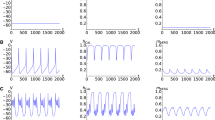Abstract
A continuum model for a heterogeneous collection of excitable cells electrically coupled through gap junctions is introduced and analysed using spatial averaging, asymptotic and numerical techniques. Heterogeneity is modelled by imposing a spatial dependence on parameters which define the single cell model and a diffusion term is used to model the gap junction coupling. For different parameter values, single cell models can exhibit bursting, beating and a myriad of other complex oscillations. A procedure for finding asymptotic estimates of the thresholds between these (synchronous) behaviors in the cellular aggregates is described for the heterogeneous case where the coupling strength is strong. This procedure is tested on a model of a strongly coupled heterogeneous collection of bursting and beating cells. Since isolated pancreatic β-cells have been observed to both burst and beat, this test of the spatial averaging techniques provides a possible explanation to measured discrepancies between the electrical activities of isolated β-cells and coupled collections (islets) of β-cells.
Similar content being viewed by others
References
Anderson, A. R. and B. D. Sleeman (1995). Wavefront propagation and its failure in coupled systems of discrete bistable cells modelled by FitzHugh-Nagumo dynamics. Int. J. Bif. Chaos 5, 63–74.
De Vries, G. (1998). Multiple bifurcations in a polynomial model of bursting oscillations. J. Nonlinear Sci. 8, 281–316.
De Vries, G. and R. M. Miura (1998). Analysis of a class of models of bursting electrical activity in pancreatic β-cells. SIAM J. Appl. Math. 58, 607–635.
Doedel, E. J. (1981). AUTO: A program for the automatic bifurcation and analysis autonomous systems, Proceedings of the 10th Manitoba Conference Mathematics and Computing, University of Manitoba, Winnepeg, Canada, Congr. Numer., 30, pp. 265–284.
Falke, L. C., K. D. Gillis, D. M. Pressel and S. Misler (1989). Perforated path recording allows long-term monitoring of metabolite-induced electrical voltage-dependent Ca2+ currents in pancreatic B cells. FEBS (Fed. Eur. Biochem. Soc.) Lett. 251, 167–172.
Hale, J. K. and K. Sakamoto (1989). Shadow systems and attractors in reaction-diffusion equations. Appl. Anal. 32, 287–303.
Hille, B. (1992). Ionic Channels of Excitable Membranes, Sunderland, MA: Sinauer Associates Inc.
Keener, J. P. (1987). Propagation and its failure in coupled systems of discrete excitable cells. SIAM J. Appl. Math. 47, 556–572.
Kevorkian, J. (1990). Partial Differential Equations: Analytical Solution Techniques, Pacific Grove, CA: Wadsworth & Brooks/Cole Advanced Books.
Manor, Y., J. Rinzel, I. Segev and Y. Yardom (1997). Low-amplitude oscillations in the inferior olive: a model based on electrical coupling of neurons with heterogeneous channel densities. J. Neurophysiol. 77, 2736–2752.
Mears, D., N. F. Sheppard, Jr., I. Atwater and E. Rojas (1995). Magnitude and modulation of pancreatic β-cell gap junction electrical conductance in situ. J. Membrane Biol. 146, 163–176.
Meda, P., I. Atwater, A. Goncalves, A. Bangham, L. Orci and E. Rojas (1984). The topography of electrical synchrony among B-cells in the mouse islets of Langerhans. Q. J. Exp. Physiol. 69, 719–735.
Meissner, H. P. (1976). Electrophysiological evidence for coupling between β-cells of pancreatic islets. Nature 262, 502–504.
Morton, K. W. and D. F. Mayers (1994). Numerical Solution of Partial Differential Equations, Cambridge: Cambridge University Press.
Perez-Armendariz, M., C. Roy, D. C. Spray and M. V. L. Bennett (1991). Biophysical properties of gap junctions between freshly dispersed pairs of mouse pancreatic beta cells. Biophys. J. 59, 76–92.
Pernarowski, M. (1994). Fast subsystem bifurcations in a slowly varying Lienard system exhibiting bursting. SIAM J. Appl. Math. 54, 814–832.
Pernarowski, M. (1998). Fast and slow subsystems for a continuum model of bursting activity in the pancreatic islet. SIAM J. Appl. Math. 58, 1667–1687.
Sherman, A. (1994). Anti-phase, asymmetric and aperiodic oscillations in excitable cells—I. Coupled bursters. Bull. Math. Biol. 56, 811–836.
Sherman, A. and J. Rinzel (1992). Rhythmogenic effects of weak electrotonic coupling in neuronal models. Proc. Natl. Acad. Sci. 89, 2471–2474.
Sherman, A., J. Rinzel and J. Keizer (1988). Emergence of organized bursting in clusters of pancreatic β-cells by channel sharing. Biophys. J. 54, 411–425.
Smith, P. A., F. M. Aschroft and P. Rorsman (1990). Simultaneous recordings of glucose dependent electrical activity and ATP-regulated K+-currents in isolated mouse pancreatic β-cells. FEBS (Fed. Eur. Biochem. Soc.) Lett. 261, 187–190.
Smolen, P., J. Rinzel and A. Sherman (1993). Why pancreatic islets burst but single β-cells do not: the heterogeneity hypothesis. Biophys. J. 64, 1668–1680.
Terman, D. (1991). Chaotic spikes arising from a model of bursting in excitable membrane. SIAM J. Appl. Math. 51, 1418–1450.
Author information
Authors and Affiliations
Additional information
This work was supported by the National Science Foundation Grant DMS-97-04-966.
Rights and permissions
About this article
Cite this article
Pernarowski, M. Fast subsystem bifurcations in strongly coupled heterogeneous collections of excitable cells. Bull. Math. Biol. 62, 101–120 (2000). https://doi.org/10.1006/bulm.1999.0143
Received:
Accepted:
Issue Date:
DOI: https://doi.org/10.1006/bulm.1999.0143




